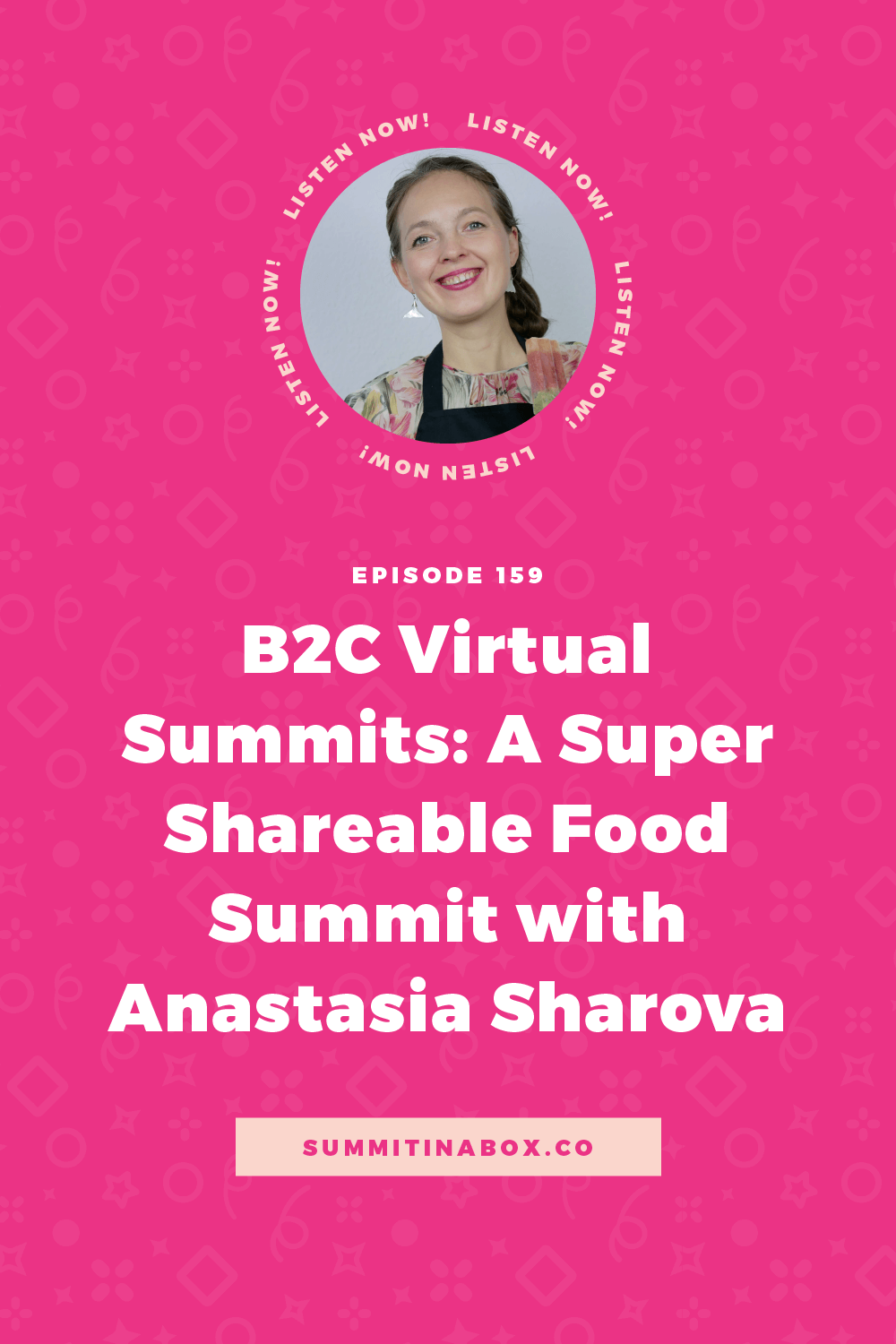You probably hear about more Business-to-Business (B2B) summits because you're a business owner. But that doesn't mean that Business-to-Consumer (B2C) summits aren't happening, or that they're not creating powerful transformations for the hosts, speakers, and attendees.
Anastasia’s Business and Summit Background
I’m an online video strategist and a certified chef. I also run an online healthy cooking school, Happy Bellyfish. This summit brought together my two biggest passions and allowed me to teach others how to eat healthily and have fun in the kitchen with their food.
Summit Goals
If I was to name my goal in one sentence, it would have been to reach a much wider committed audience. And this summit was my motivation to do that.
Food and cooking information are widely available on YouTube or Pinterest, but a virtual summit where attendees participate interactively with the instructor is what made my summit stand out.
The attendees that came to the sessions or bought an all-access pass had a strong commitment to DO something with the information and knowledge that we shared with them.
B2C vs B2B Summit Audiences
When I started my business, I had many doubts and even catered more towards the B2B audience with my offers.
But I learned that with the B2C audience, you'll talk a little differently than you would to a B2B audience. There are certain things you need to consider with this audience. For instance, when you communicate the value of your offer to a B2C audience, it can take more time for them to warm up to you and what you can offer.
But I think a B2C summit can be even more successful because there aren’t many offered in the space and people crave that connection.
The Juicy Details
We followed the free virtual summit model. At first, I was concerned with this model and wondered if we should have a low-ticket cost to attend.
We reevaluated our goal of wanting to reach as many people as possible and build our list with an engaged audience. After doing that, we knew it needed to be a free ticket.
The all-access pass cost $47 during the fast-action period, which felt affordable to our audience. It was then $67 after the fast-action offer and $97 by the end of the summit.
The summit had 17 live sessions and nothing was prerecorded. The whole idea of the event was to bring in life and energy that can only happen when you’re live.
But because not everyone can make it live, the sessions were recorded, and attendees had 24-hours to rewatch them.
While my all-access pass conversion rate wasn’t very high at 3.5%, it was more of an experiment and passion project to produce this summit. We didn’t focus on building or promoting the all-access pass. Industry standards are 3-5%, so we fit right into the standards, without focusing on it.
A Focus on Live Interactions
While most summits have presentations that follow a certain format, we didn’t want all of our sessions to be the same thing on repeat. We wanted variety and ways to make it more interactive and exciting.
To help, we had 3 types of sessions:
- Cooking workshops – These were live cooking sessions where chefs cooked or made home remedies based on ancestral knowledge and knowledge from other cultures.
- Interviews– We only had a couple of speakers who did interviews, and these were the farmers who grew the ingredients. It was a neat experience to bring them into the summit space because they usually aren’t included. They were able to talk about the knowledge and experience they have with growing and choosing these ingredients.
- Presentations – We had very few presentations as our goal was to focus on live interaction and have attendees attend and participate live with the summit and the speakers.
We determined which type of presentation each speaker would do based on the expertise of the speaker.
For example, the chefs or herbalists who had the skills to share recipes and cook together live on camera were given cooking workshops. We had a couple of farmers and doctors where cooking live isn’t their niche but are experts in their field of producing healthy foods, so they were a good fit for either a presentation or an interview.
What Made the Summit So Shareable
It was mind-blowing to see 100 people or more all cooking together in some of the sessions. It was so fun and that encouraged the attendees to share the summit with their family and friends.
Attendees were able to create something with their own hands that are visually appealing, and when you do that, you want to share that experience with others.
We expected the attendees to enjoy the cooking workshops the most, but we were surprised to hear the attendees really did enjoy the summit presentations and interviews too.
My advice to you
In the beginning, I looked at the summit as a launch tool, but now my experience with it showed me was so much fun to make, too. I’m excited to run the next ones.
The best products are the ones you’re excited about.
About Anastasia

Anastasia Sharova is a serial entrepreneur, an online video strategist, a certified plant-based chef, and a children’s books author.Anastasia owns a boutique online video agency, which helps entrepreneurs, changemakers, and creatives reach their audiences through video content, and build their brands on YouTube.Anastasia is the founder of Happy Bellyfish, an online cooking school, which focuses on healthy eating habits and traditional natural foods. Happy Bellyfish offers virtual cooking courses and experiences, bringing fun back into the kitchen and spreading the love and art of healthy nutritious food.







